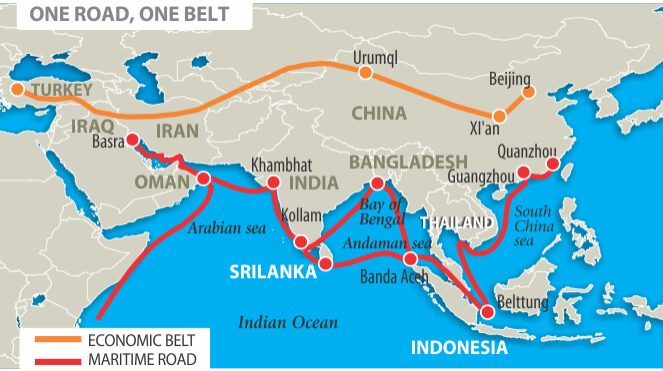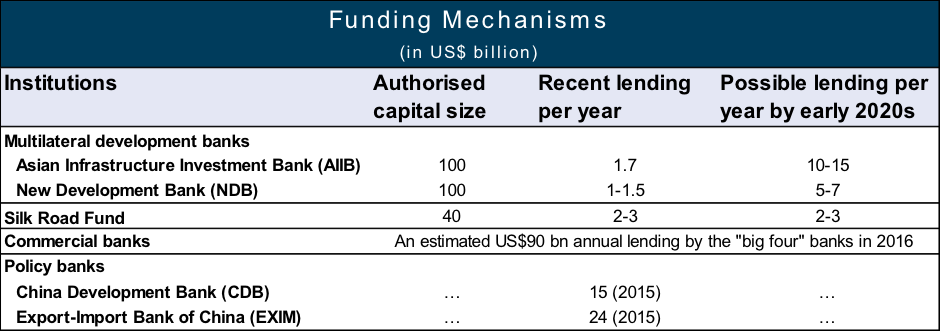GET IN TOUCH
- Please wait...

The recent SCO (Shanghai Cooperation Organization) summit, taking place on 8th and 9th of June, 2017, saw heads of states from Russia, India, Pakistan, Kazakhstan, Kyrgyzstan, Tajikistan, and China but it also solidified the paradigm shift of world power in terms of trade, infrastructure, fuel, energy, transportation, development, and finance. As Bangladesh is becoming a part of this initiative in the upcoming future, it’s important to understand the crux of the whole venture and how Bangladesh can reap the benefits.
WHAT IS THE OBOR INITIATIVE?
Introduced and spearheaded by Chinese President Xi Jinping in 2013, OBOR stands for “One Belt, One Road”. The project has two components — the Silk Road Economic Belt (SREB) that would be established along the Eurasian land corridor from the Pacific coast to the Baltic Sea, and the 21st century Maritime Silk Road (MSR). Involving 68 countries, The SREB focuses on bringing together China, Central Asia, Russia, and Europe (the Baltic); linking China with the Persian Gulf and the Mediterranean Sea through Central Asia and West Asia; and connecting China with Southeast Asia, South Asia, and the Indian Ocean. The 21st-Century MSR, in turn, is designed to go from China’s coast to Europe through the South China Sea and the Indian Ocean in one route, and from China’s coast through the South China Sea to the South Pacific in the other.

WHY IS CHINA TAKING UP THE OBOR INITIATIVE?
China is working on both political and economic fronts to make this initiative a success- and for good reason. According to some Chinese media, China has already pledged $1 trillion for the OBOR project and plans to invest more. Although the main beneficiary of this effort will be China, it will also bring about mammoth-sized infrastructural changes in the regions OBOR is vested in.
Economic Benefits:
The OBOR project will spell great economic benefits for China. Suffering from widespread overcapacity in heavy industries such as steel, cement, and aluminum, China is looking for new markets for Chinese goods. “Belt and Road” route countries will connect some resource-rich countries and the infrastructural changes that need to take place to make this happen will be funded and carried out by China itself. Some Core projects include a $54bn land route from China’s Xinjiang region to a deep-water port in Pakistan, Gwadar. It will spend $1.1bn on creating a “port city” in Sri Lanka’s Colombo, across from Gwadar. A planned 3,000km (1,900 miles) high-speed rail line from southwest China to Singapore will also be built in addition to improving the export opportunities. All these infrastructural developments make this project greatly desirable for both the parties involved. (Source: Financial Times)
Geopolitical Benefits:
The OBOR initiative will give China access to some strategically important geopolitical countries- all the while China is the country that will provide additional security and protection. For example, China has recently established a 1,100-mile oil and natural gas pipeline from Myanmar’s Arakan coast in the Bay of Bengal all the way to Kunming, a major city in China’s southwest Yunnan province which will reduce China’s dependence on Malacca straits (through which about one-fourth of the world’s trade goods pass) and make China’s future secure in terms of energy in the foreseeable future. It will also help China to leverage its financial footing to assert geopolitical influence from East Asia to Africa. Ultimately, it’s a soft power move by China that will remake the world order.
HOW IS CHINA FUNDING IT?
To provide development funding for the OBOR, China launched three new initiatives recently: the Asian Infrastructure Investment Bank (AIIB), the New Development Bank (NDB), and the Silk Road Fund, with a total initial capital base of $240 billion.

Here, however, some caution is advised. According to some European economists and experts, the OBOR initiative is nothing but a debt instrument and this voice of concern cannot be ignored either; since, in some cases, China is charging interest rates as high as 16 percent. Accumulated, these debts can become a trap for some countries which are still infra-structurally weak to repay the debts on their own and thus can fall into a debt trap. The same concern was shown by India in May when Indian PM refused the invite to the OBOR conference. However, India has since changed its stance and, in the recent SCO summit, pledged to join the initiative.
IMPACT OF THE OBOR INITIATIVE
Economic Impact:
OBOR generated infrastructure will facilitate trade investment and trade, and contribute to the global output. In some poorer countries, where infrastructural development is significantly low, this initiative can create new market demand. OBOR infrastructure could further boost growth in an already rapidly growing part of the world. GDP growth in OBOR countries averaged 4.2 percent in 2014-16, compared to the global average of 2.6 percent. According to some experts, “By 2050 the OBOR region will contribute 80 percent of global GDP growth, with China’s share remaining broadly stable at around 40 percent and that of the rest of Asia doubling from the current 15 percent to over 30 percent.”
Political Impact:
Dubbed the next Marshall Plan (carried out in western Europe which brought about and asserted the global dominance of the US), the OBOR initiative could very well change the political landscape of the world. If executed well, this project will ensure China’s stronghold on regions, such as Africa, East Europe, and East Asia. China may control from deep sea ports to trade routes whilst creating their own routes as they please in the future. This upheaval may very well make Renminbi (RMB) a suitable substitute for the US dollar.
HOW BANGLADESH COULD BENEFIT FROM OBOR PROJECT
Bangladesh is important for the OBOR initiative for several reasons: the huge population of BD and their rising disposable income is one of the most important aspects. Geopolitically, Bangladesh is at an attractive advantage. Bangladesh’s availability of cheap labor, physical and political proximity to India, and most importantly the proximity to the Bay of Bengal is severely important for China’s geopolitical and geo-economic interests. Around 80 percent of China’s energy imports pass through the Malacca straits via the Indian Ocean. To assert more control over the Indian Ocean and Malacca straits China fervently needs the cooperation of Bangladesh. Considering all of these, Bangladesh could emerge as a key player in the OBOR initiative.
Becoming the prime destination for China’s Sunset Industries:
China is shifting towards high-tech, high-margin, and high-end industries, such as IT, Aerospace, and Telecommunication. Existing Chinese companies that deal in low-tech labor-intensive industries are trying to relocate their manufacturing plants to places that offer cheap labor and quality work. Bangladesh whose key demographic is between the ages of 15 to 30 could very well become the prime destination for these industries.
Bringing in Loans and Foreign Direct Investments:
During the visit of Chinese President Xi Jinping in October 2016, 34 Memorandum of Understandings had been signed between Bangladesh and China worth $13.6 Billion in trade and investment. In addition, $20 billion in loan agreements have been carried out by both governments. These investments will welcome future FDIs that will most definitely help the BD economy to get bigger. Apart from ADB and World Bank, the newly established AIIB (Asian Infrastructure Investment Bank) could become a major source of foreign loans for infrastructural development in Bangladesh.
BCIM (Bangladesh-China-India-Myanmar) Economic Corridor:
Bangladesh is centrally situated in the BCIM corridor which spells a great export opportunity for Bangladeshi products. Bangladesh has already requested duty-free access to 22 Bangladeshi products, which if granted, will help to substantially decrease the trade deficit of the country. Bangladesh also occupies a strategic position along the Maritime Silk Road (MSR) with its Chittagong port as a major maritime hub through the Indian Ocean and it will be more so once the Chinese Special Economic Zone at Chittagong becomes operational in a few years’ time. Bangladesh is already constructing a deep seaport in Sonadia to accommodate larger ships and better transportation opportunities.
China’s One Belt One Road Initiative offers a huge opportunity for countries to stimulate economic growth through massive infrastructure development which in turn will enable greater flows of trade across borders. Bangladesh with its unique geopolitical position between China and India stands to gain a lot of it can ride the wave of this huge opportunity. As this century is all about shared prosperity and development, Bangladesh would do well to avail full Chinese cooperation.
Research conducted by Kazi Ahmed Arif Fuad, Junior Associate, LightCastle Partners.
Our experts can help you solve your unique challenges
Stay up-to-date with our Thought Leadership and Insights